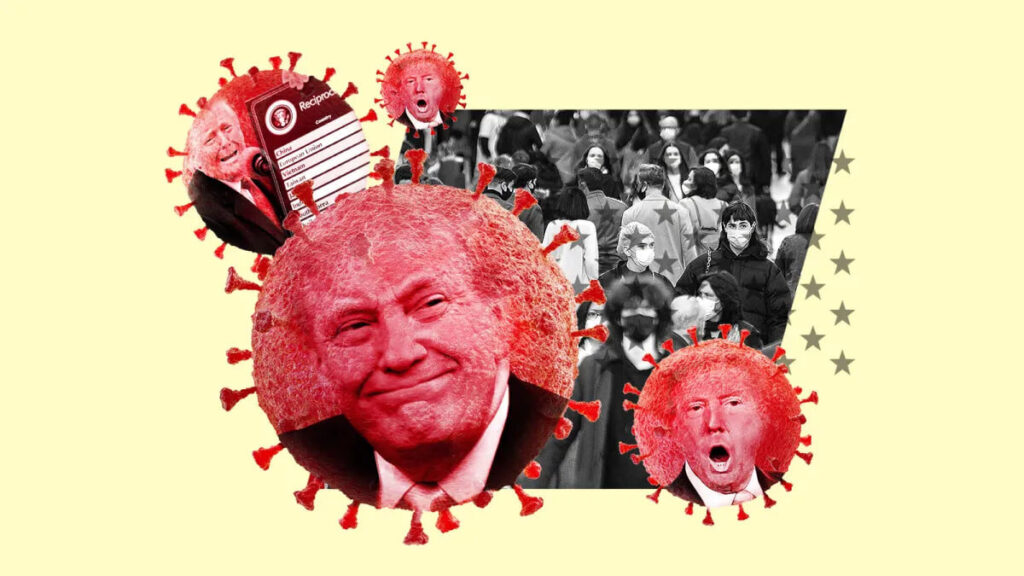Tehran – In an commentary on April 18, the Times newspaper is as devastating as the Covid-19 pandemic, which likened cleaning fees for Donald Trump’s country, particularly China, and seriously harmed the global economy. “Trump is the biggest source of uncertainty since Covid-19,” the newspaper said.
Below is an excerpt from the article.
It has been five years since the global economy was hit by the devastating shock caused by the Covid-19 pandemic. You may find analogy strange, but we are marking the fifth anniversary of the Covid-19 pandemic with a shock that is very similar to the global economy.
The number of passengers flying from overseas to the US fell sharply. The ship, full of American-bound goods, has stopped. All over the US, businesses quickly increase prices and start dropping out employees. However, this new shock is not caused by the coronavirus, but the mind virus.
The virus in the mind is President Trump’s belief that by increasing the average US tariff rate by about ten times, he can make America great again, for example, recovering manufacturing employment in 1972.
Millions of Americans who voted for Trump, whether they knew it or not, voted for a fundamental change in American trade policy. Trump tried to offer this in his first term and failed. He explicitly campaigned as the “customer man” in 2024, citing President William McKinley as his role model and pledged the Mutual Trade Act.
Having won re-election with a wider margin than voters had predicted, Trump concluded that he had a duty to return the economic clock to around 1909 and impose tariffs at a much higher level than we knew in our lifetime.
In 2020, Covid-19 spread across global social networks connected at airports around the world, changing those networks forever. Today, Donald-25 has the same effect on networks known as supply chains. In 2020, other parts of the world responded to the pandemic by using fiscal and monetary stimuli to offset the shock. Now, in response to the American heart virus, other parts of the world are being forced to do the same.
It was the recent travel statistics that first stirred up Covid’s half-filled memories. According to the International Trade Bureau, the number of visitors from Western Europe who stayed in the US at least one night fell 17% in March compared to a year ago. Travel volumes fell by more than fifth in some countries. Flight cancellations by travelers in Canada, France and Germany are surged. In fact, Canada’s bookings for flights to the US have dropped by 70%.
Of course, these are less responsive to Trump’s tariffs when it comes to his general training treatment of American allies. In particular, his inflammatory claim that Canada should be the 51st nation, and the devastation of Europeans at Vice President JD Vance at the Munich Security Conference in February. Foreigners have read news stories about non-citizens being deported from the United States to El Salvador. Such a story is offensive.
But actions like the global economy’s pandemic have more to do with tariffs than anything else. The amount of products entering the Port of Los Angeles has already dropped sharply. Daily container reservations on US-China trade routes have fallen by the quarter since the end of March compared to this period last year.
On the East Coast, the latest New York Federal Reserve Imperial Survey shows a sharper decline in business expectations than in early 2020. Uncertainty in US and global policy clearly shows that Trump is the source of the biggest uncertainty since Covid-19.
Five years ago, no one was sure what the Covid fatality rate was. The recommendations of people with names that our social and economic lives should be “locked down” have suddenly stopped a large part of human activity.
The equivalent uncertainty for 2025 is that no one knows where US tariffs will be tomorrow. As a result, the bulk of the trade between the two largest economies in the world will be blocked. Like a pandemic, this means it is taking a major blow to the global economy as a whole.
Jpmorgan said last Wednesday that it was “highly likely” that the US economy would shrink later this year. In addition to fears of a recession, we narrowly avoided a full-scale financial disaster in the US bond market on April 9th. This had to ease firefighting activities on assets in mid-March 2020 to the Federal Reserve scrambled to raise cash.
It is important to put the tariffs he has imposed since his inauguration in a historical perspective to understand why Trump’s trade policy proves almost as economically destructive as the pandemic. The average US tariff rate from the 1940s to the 2010s fell, reaching an all-time low of 1.27% in 2008.
From the year I was born (1964), the average was 3.67%. Even after Trump’s “liberation day” and after two stages, Bloomberg’s economics shows that the average tariff rate last year is over 20%.
This represents more than just a massive tax hike on Americans. It’s as if the US is imposeting economic sanctions on itself. This is because no one is sure what the cumulative rate is, as the most fundamental part of Trump’s trade war is made up of tariffs on China, and is currently so high. (The White House said Tuesday it was 245%. China’s Foreign Ministry questioned its arithmetic.) It was secretly announced eight days ago, even after exemptions on smartphones, laptop computers, hard drives, computer processors and memory chips.
To illustrate the point, we will introduce some of the product categories in 2023, where between three-thirds of US imports came from China. It is essentially the contents of all target stores in America.
Trimming all these prices is a supply shock comparable to the energy crisis of the 1970s. This is imposed by the Arab government to raise crude oil prices on American consumers, while this is imposed by their own government.

